Botnets by Email
I make no effort to hide my email address, which means that I know the instant a new email-based virus, phishing attack, or penny-stock-pumping scam launches when my inbox floods. Most such emails are easy to distinguish from legitimate emails because of their lack of personalization, poor grammar, or low-quality images that attempt to foil spam filters. On occasion, however, I get a message that causes me to examine it a little more closely in order to make sure it’s junk. I also look out for ones that might trick unsophisticated users.
My family uses BlueMountain greetings to send eCards, so when I received this email I took a second look:
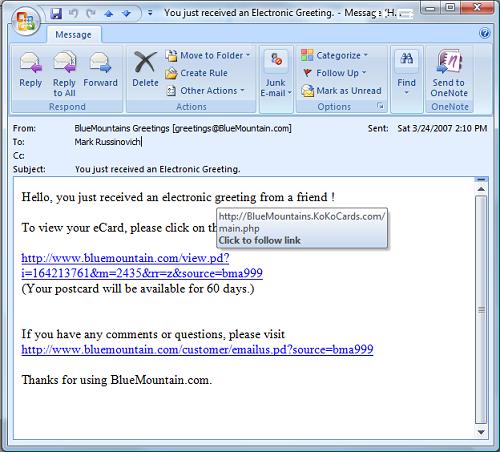
There are a couple of immediate clues that the email is a fake. For example, the body doesn’t address me by name and there’s a space between “friend” and the exclamation point. Hovering the mouse over the link shows that it masks an address at a different site, but the presence of BlueMountains and the legitimate-looking KoKoCards in the name might be sufficient to fool a casual scan.
Curious to see what kind of con the email was perpetrating, I fired up a virtual machine that was isolated from the local network and clicked on the link. Instead of being taken to a web site like I expected, an Internet Explorer dialog appeared and asked me if I wanted to save or run “Postcard.jpg.exe.” Most users that might have followed the ruse this far would probably be suspicious and not run it, but out of curiosity I started Process Monitor to watch the action and ran it. What I found isn’t very sophisticated, but it’s interesting because it’s an email virus that’s making the rounds today.
First I saw the flash of a command prompt window starting and exiting and then a prompt from the firewall appeared:
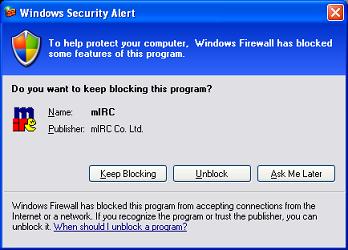
I immediately recognized that the program wanting through the firewall is a popular Internet Relay Chat (IRC) client. I unblocked it, waited a couple of minutes, and then turned my attention to Process Monitor to see what had transpired. I opened the process tree tool from the Tools menu, which shows all the processes that generated activity in a tracing session, including ones that have exited. I saw evidence of the initial installer, the command prompt that I had seen, and a Regedit child process of the command prompt, all of which have faded icons to show that they had exited by the end of the collected trace:
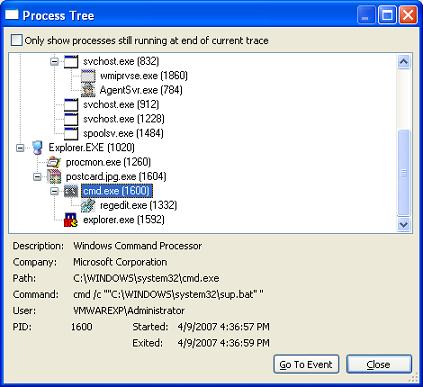
The command prompt’s command line, visible in the process tree, indicates that it was launched to execute a batchfile, sup.bat. Sup.bat was left in the System32 directory, so I could see from its contents that it passes Regedit a registry file named sup.reg, which creates two auto-start entries:
REGEDIT4
[HKEY_LOCAL_MACHINE\Software\Microsoft\Windows\CurrentVersion\Run]
"taskmgr"="C:\\WINNT\\system32\\explorer.exe"
"IExplorer"="C:\\WINDOWS\\system32\\explorer.exe"
The seemingly redundant entries simply ensure that mIRC will autostart when the system boots regardless of whether the system directory is Winnt or Windows.
The process tree showed only one additional process still running, mIRC, which was using Explorer as its cover name to blend into the list of legitimate programs a user would see in Task Manager. Process Monitor of course reveals “explorer’s” true identify by showing the mIRC icon, description and company name:
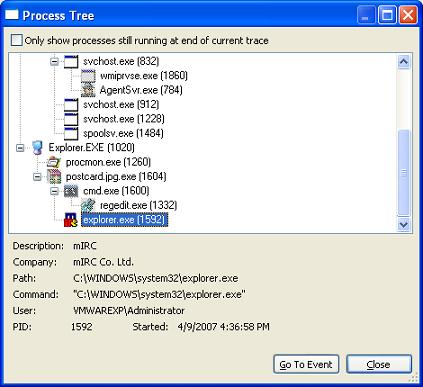
The mIRC I had on my system was unmodified from the one on the mIRC homepage. My guess is that the malware author didn’t alter the description or company name because they don’t show up in versions of Task Manager prior to the one in Windows Vista, and antivirus is left faced with the difficult position of flagging a legitimate program as malware.
Having completed my examination of the process tree, I returned to Process Monitor’s tracing window and scanned through the output. I set a Category filter to include operations in the Write category, which narrowed the output to modifications made during the installation and first run of mIRC. I quickly ran across a string of writes to .ini files in the \Windows\System32 directory:
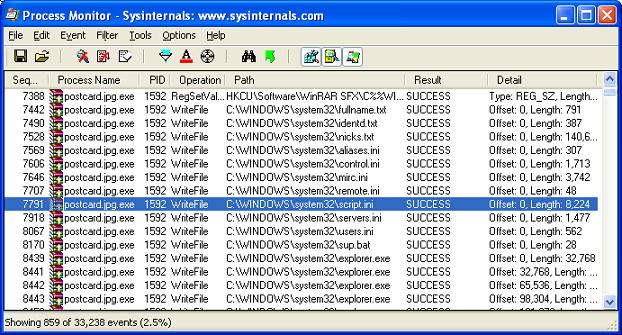
I’m not familiar with mIRC, but after studying the contents of the files for a few minutes I figured out that the files cause mIRC to automatically join chat channels named mp3-w4r3z and mp3-download on a chat server randomly selected from the ones stored in the Server.ini file, all of which are in the undernet.org domain. Finally, the heart of the operation is the script.ini file, which appears to implement commands that remote users can execute, including “run.”
At this point I concluded that what I had installed was a very simple Botnet client. I left it running for several hours, but didn’t notice any further activity. Surprised that the system hadn’t become an active Bot, I opened mIRC and manually connected to several of the servers listed in the Servers.ini file, but none of them had mp3-w4r3z or mp3-download channels, so they had either been shut down or hadn’t been configured, yet.
A few days later I received a similar email, but this time Microsoft’s spam server had stripped the contents and indicated that what I had installed was Trojan-Spy.HTML.Pcard.w, but an Internet search for more information didn’t yield anything meaningful.
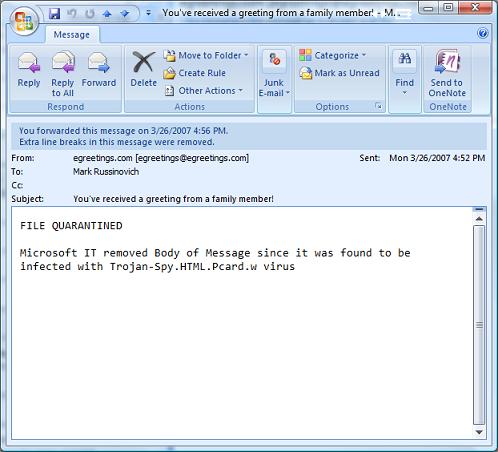
I’m left wondering how successfully this type of lure brings users into a Bot herder’s web. There are numerous warnings that something funny is going on, from the lack of personalization to being asked to run a program and open a port in the firewall (and on Windows Vista there’s an additional UAC elevation prompt to give administrative privileges to Postcard.jpg.exe). The fact that this Bot herder didn’t bother with more sophistication leads me to believe that it’s still unnecessary: enough people ignore the warnings.
Users will get more wary, however, so we’re in store for craftier attacks that will fool even paranoid users. Other spam and virus emails I’ve received address me as Mark, which I assume they get from my old mark@sysinternals.com address, but there are other tricks for guessing or even obtaining a user’s name, like contact harvesting. Exploits of zero-day and unpatched vulnerabilities can deliver malware without user interaction, and malware can use communications techniques, like proxy servers, http traffic, or outbound-initiated bidirectional connections, to avoid causing firewall popups.
Windows Vista’s UAC and Protected Mode IE can help mitigate attacks, but adoption will take time and even these technologies give malware a lot of room to play. There’s work going on at Microsoft to address these threats, but there’s no silver bullet. The fight against malware continues.
Comments
Anonymous
January 01, 2003
PingBack from http://windowstips.wordpress.com/2007/04/18/me-prestas-tu-equipo/Anonymous
January 01, 2003
Well, we all know that we shall not click on links in mails and stuff like that. Marc Russinovich didAnonymous
January 01, 2003
PingBack from http://www.rc.au.net/blog/2007/04/16/20070416-daily-security-reading/Anonymous
January 01, 2003
Pocas veces uno tiene la oportunidad de entender que tan vulnerables somos en este ciber-espacio. Y peorAnonymous
January 01, 2003
"HSANTOS: There is only one solution - stop running DATA as CODE!" You mean, we should stop using stored program machines? Go back to the days when you have to rewire the system to make it do different things? I'm sure that'll go over really well...Anonymous
January 01, 2003
PingBack from http://thanadon.com/news/botnets-by-email-bluemountain-greetings.htmlAnonymous
January 01, 2003
Hoy en cosas interesantes: Diseñando cubos en SQL Server para usarlos en PivotTables de Excel 2007, CreadorAnonymous
April 09, 2007
Thanks for the read Mark, I'm really excited about the UAC article that you're going to post in the June issue of technet magazine though! Can we get any previews at all?Anonymous
April 09, 2007
Interesting as usual! Although it would have been more interesting had you actually discovered some activity.Anonymous
April 09, 2007
Much people say that Windows is too unsecure, from my point of view the truth is that there is a lot of careless people and logically should have more careless people in Windows just for the amount of usersAnonymous
April 10, 2007
Thats an interesting article and interesting stuff. Now I want to playaround with Process Monitor.Anonymous
April 10, 2007
Very interesting, glad to see you back with an article, I love em! :-) I think much of the novice users just click away dialogs and click links because they don't read them, they don't think it can be a scam and if they do, they don't understand what it all means. It's too much for them. Education is needed here!Anonymous
April 10, 2007
Hi Mark, interesting read. Could Outlook be updated so that if the displayed URL and the linked URL don't match, then Outlook could launch InternetExplorer in a "Safe" mode that is more protected ( and maybe also has a indicator that that particular session could be dangerous - e.g, a RED border ). Unfortunately the ease of use of applications ( including Outlook ) make these types of attacks much more likely to occur, and much harder for non-tech savvy users to fall for.Anonymous
April 10, 2007
I also got some of these "postcards", and they are crude malware. In fact, the executable is a WinRAR Self Extract Executable (SFX). When you run it, it unpacks the files and starts a script. You can see the WinRAR SFX icon in your screenshot.Anonymous
April 10, 2007
Come on, man! What's happening to you? You used to post some great "research & internals" articles... Now this?!Anonymous
April 10, 2007
Excellent! Very informative. And, I might add, gutsy.Anonymous
April 10, 2007
I just wonder why Mr. Russinovich isn't aware of the security vulnerabilities in the HTML renderer? There are various ways to even fool the hovering text and the status bar to point at any URL you like, whereas clicking on the URL takes you somewhere completely different. Classical examples are styled form buttons within a label tag, or links within a table, and you know, these have never been patched (not even on Vista). Actually you should feel glad that you never clicked the Reply button, since this would allow the attacker to inject arbitrary HTML code into the reply window (including JavaScript and ActiveX being turned on there by default, yikes!). One would think that Mark should know how to differ a serious mail client from a hardly RFC-conformant wannabe-mail-client ActiveX Rich Platform Client.Anonymous
April 12, 2007
that's why i don't use mail client with use of IE rendering. My client has its own renderer, so there are less chances it can be vulnerable.Anonymous
April 12, 2007
I was actually wondering... Since so many of these programs require administrator access anymore... Why isn't there a simple "Do not run this program as Administrator" option in the Compatibility section. It would at least make users a little more happy when a program has the requirement for Admin rights (Say an installer) and dumb it down a bit. That way, users could be (stupid) and run these types of programs NOT as administrators. >.> Some of the Administrator rights should be up to the users, not the devs of the programs they make >.<Anonymous
April 13, 2007
@wroot: Actually, Outlook2007 does not IE for rendering, as I understood it is the rendering engine from Word. @Anonymous: "re: Hovering URL can't be trusted either " Outlook IS a serious mail client - just because it is used by so many businesses. I think you did not get the message of what Mark was trying to do - he was just showing how an usual everyday-attack via Mail works and what a typical user would most likely sees - not to show what could be possible beneath this.Anonymous
April 13, 2007
> Outlook IS a serious mail client - just > because it is used by so many businesses. Many people abusing it as a mail client doesn't make it one. > how an usual everyday-attack via Mail works > and what a typical user would most likely > sees No, he didn't. Everyday-attacks involve spoofing whereas the hover text will not show the real destination, and in fact one should wonder why the attacker didn't even install the malware without the user's consent (since there are so many unpatched vulnerabilities that Microsoft don't care for). Sorry, but in the scenario Mark pointed out, you have already lost from the beginning, where untrustworthy content getting processed by Outlook.Anonymous
April 18, 2007
thanks Mark for this little enjoyable article as some people said ,the point is user attention to the attack based on 'social engineering'. right? anyway,Most of your works impressed me and i'm looking forward to reading your professional detailed articles.Anonymous
April 29, 2007
It's interesting to look into that bot program a little deeper. It seems like a generic bot. I downloaded a couple of those. The only difference between them was channels they connect to and users that can control them. I connected to some of those channels. On one of them there were about a hundred users with seemingly random names. Those are bots. Or in other words they are compromised machines that are just sitting there waiting to be taken control of. Users who can control them are usually channel admins. So you can immediately tell who the hackers are. They can control all the bots on the channel simulteneously with commands posted to the channel. This is some serious power that can be leveraged in many ways. For example, If programmed for a DDoS attack they can take down a moderate bandwidth site.Anonymous
May 05, 2007
The comment has been removedAnonymous
May 08, 2007
Wow goes to show how complicated spyware has gotten. I just don't know why someone would stay on the computer so long to make some spyware to hurt someone else's computer. It's rediculous. At least webhosters are doing some good to the world.Anonymous
May 16, 2007
Seems like an extremely crude piece of malware. Got to agree with Camus SoNiCo, writing about such a poorly constructed malware is a dissapointment. I suspect you were hoping to infiltrate the irc channel and bring the botnet down from the inside out, pity it didn't work out like that.Anonymous
May 20, 2007
The comment has been removedAnonymous
May 30, 2007
The comment has been removedAnonymous
July 20, 2007
Interesting that the program asks to open a firewall port. The problem with Microsoft's firewall is that you can add an entry with no user rights to the registry to give access to the port. The user would of have to wait for a reboot to use the port but that should in the majority of cases be within a day or a month or two for a server.Anonymous
August 11, 2007
The comment has been removedAnonymous
August 04, 2008
"HSANTOS: There is only one solution - stop running DATA as CODE!" Are you referring to an executable data? Seriously? Did you read the article? Oh lordy...